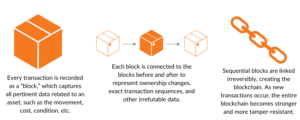Blockchain: The New Fraud Fighting Tool
October 5, 2021
At a glance:
- More than a trend: From banking and currency to supply chain and manufacturing, blockchain technology can support a wide range of industries by delivering immediate, transparent, and secure information.
- Blockchain as a fraud preventative: Real-world uses for blockchain technology continue to expand as users realize its full potential to combat fraud; however, no system is perfect, and even blockchain has vulnerabilities.
- Next step: Businesses should evaluate blockchain as a potential solution for securely tracking and sharing information while remaining vigilant of potential fraud.
Get ahead of the fraud risks by partnering with an experienced team. Schedule a consultation today.
The full story:
Most people think of blockchain as being synonymous with cryptocurrency, assuming the technology only lends itself to financial transactions. The truth is that applications of blockchain technology extend far beyond facilitating Bitcoin and other popular cryptocurrencies. A wide range of industries from manufacturing to retail and pharmaceuticals are all adopting the power of blockchain technology to improve operations – and not just for the financial benefits.
The value of blockchain
Blockchain technology provides a better, more secure solution for recording transactions and tracking assets than any other technology. Part of blockchain’s value is that the term “asset” can encompass nearly anything, from cash or land to patents and copyrights. Additionally, blockchain relies on transparent record-keeping on the movement of those assets, making it an ideal solution for both financial and supply chain applications.
The transparency and versatility afforded by blockchain can be traced to the technology’s three primary characteristics:
- Decentralization – everyone has equal visibility into transactions and jointly controls the whole system
- Authentication – all participants for every transaction can be verified
- Tamper-resistance – transactions cannot be changed or reversed once posted
These characteristics are made possible because of the very nature of the blockchain process, illustrated below:

If you’re interested in a more detailed representation of how blockchain works. However, even a basic understanding demonstrates the universal benefit of a technology that can support transparent, accurate, and secure transaction-level data compatible with any assets.
A new fraud fighter
This article has mentioned blockchain’s secure and tamper-resistant qualities more than once, but it’s important to underscore how those innate qualities provide an unequivocally strong defense against fraud. The unique intersection of transparent, authenticated, and immutable data creates a particularly hostile environment for fraudulent activity.
As blockchain usage has continued to grow and diversify, there are three stand-out ways blockchain can help combat fraud:
- Transparent supply chains – Blockchain’s ability to record exact sequential data related to any type of asset is revolutionary for the manufacturing and distribution industry as it means unprecedented insight into every step of the supply chain. This transparency can help both consumers and producers to verify the legitimacy of products they buy and the suppliers they trust.
- Smart contracts – Blockchain’s reliance on sequentially linking data allows buyers and sellers to enter into a technology-powered contract that eliminates the mediator. Smart contracts are effective because they can prevent one step of the process or transaction from beginning until the previous step was completed and verified. Read more about these here.
- Identity fraud prevention – A major driving factor behind blockchain’s security is the constant reconciliation of blockchain ledgers, which can only occur when verified by both sides of a transaction. If both parties have to acknowledge the transaction, it is much harder for a fraudster to hide their tracks. Additionally, blockchain supports permissioned networks, providing identity management to control users’ access.
Nothing is 100% fraud-proof
Even though blockchain offers some powerful anti-fraud tools, it is not impermeable. Cybercriminals can evolve their tactics just as quickly as the technology advances, meaning what is safe today is not necessarily safe tomorrow.
As with most software and technology, the users themselves are typically the weakest link in a blockchain network’s security. If a cybercriminal steals a user’s private account information, such as a username and password, there is no way to stop a fraudulent transaction and virtually no way to reverse it. Again, cybercriminals are smart, and they know it is easier to hack user’s private information than to hack the blockchain. This means any edges of the network, web interfaces, and especially IoT devices that users interact with to access the blockchain are especially vulnerable.
The bottom line
Implementing blockchain technology can have major benefits for your business’s cybersecurity and fraud prevention strategy, but it’s not foolproof. Take the extra step towards cyber fraud protection by partnering with Aprio’s Litigation Support and Forensic Accounting team. Our experts are skilled in understanding blockchain and its relationship to fraud, especially as it pertains to conducting investigations into fraud.
Recent Articles
Stay informed with Aprio.
Get industry news and leading insights delivered straight to your inbox.
